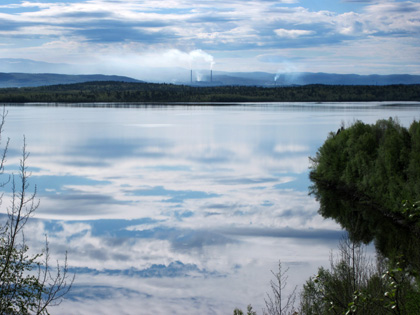Threats to the Environment
Pechenganikel sulfur dioxide emissions have decreased
 The air quality in the Inari-Pasvik River region is strongly affected by emissions from the metallurgical industry in the Russian border towns of Nikel and Zapolyarny. For the past few decades large amounts of sulfur dioxide and heavy metals have been emitted from these industrial complexes.
The air quality in the Inari-Pasvik River region is strongly affected by emissions from the metallurgical industry in the Russian border towns of Nikel and Zapolyarny. For the past few decades large amounts of sulfur dioxide and heavy metals have been emitted from these industrial complexes.
The smelter in Nikel and roasting plant in Zapolyarny were established in 1933. During the first 30 years of production, approximately 100 000 tonnes of sulfur dioxide (SO2) were emitted annually.
Locally mined ore with a sulfur content of approx. 6.5% was used during the early years of the smelter’s history but from 1971 onwards the smelter started to import ore with sulfur content close to 30% from Norilsk in Siberia. This change in the raw material led to a dramatic increase in sulfur emissions. The rise culminated in 1979, when emissions were calculated to be about 400 000 tonnes of SO2.
In the 1990s, sulfur dioxide emissions first reduced as a result of nickel and copper production level reduction and later due to a shift to local ore, as well as the company’s measures for the promotion of environmental protection.
Although nowadays the emissions are lower than in the 1980s, the measured SO2 concentrations in the Nikel area are still above the critical level for sensitive biota.
Around 100 000 tonnes of SO2 are nowadays emitted from the smelter yearly (estimated by the Pechenganikel combine). This is of the same order of magnitude as the total emissions of sulfur in Finland (60 thousands tones) and about 5 times higher than the total Norwegian emissions (about 18 thousands tonnes) in 2010.
A wide range of heavy metals, such as nickel (Ni), copper (Cu), cobalt (Co) and arsenic (As), are also released into the environment during the production processes. Nickel and copper are the main heavy metal pollutants emitted by the smelters. During 1977 annual emissions of Ni and Cu were calculated as 539 tonnes and 323 tonnes, respectively. According to the Pechenganikel combine’s official numbers, the emissions in 2010 totaled 306 tonnes of Ni and 150 tonnes of Cu.
Other sources of air pollution in the region are considered to be small in comparison with the emissions from the Pechenganikel smelter complex.
Emissions harmful for people and the environment
High sulfur dioxide (SO2) concentrations in the ambient air can have a detrimental effect on human respiratory functions. It can also indirectly affect human health after being converted to sulfuric acid and sulfate in the form of fine particulate matter. Sulfur dioxide is an acidic gas which combines with water vapor in the atmosphere to produce acid rain.
Both wet and dry sulfur deposition have been found to damage and destroy vegetation and to have adverse effects on soil, building materials and the watercourses.
Trace dietary elements are essential to maintain the metabolism of the human body. However, at higher concentrations they can have toxic effects. The Pechenganikel smelters emit some trace dietary elements such as heavy metals Cu and Co. These and many other heavy metals are toxic even in small quantities, and some of them are also carcinogenic. They are non-degradable, not readily immobilized in the environment and bio-accumulate in plants and animals. As a result, heavy metal concentrations may also increase moving up the food chain (biomagnification).
Modernization of the Pechenganikel combine
The Kola Peninsula mining and metallurgical industry company implemented the Pechenganikel renewal programme for mitigating emissions in 2001. The intention was to reduce approximately 90 percent of sulfur dioxide emissions and 95 percent of heavy metal and particle emissions from levels of the turn of the millennium.
In order to attain these goals, the construction of a new roasting plant for Zapolyarny and a new smelting plant for Nikel have been planned. In addition, the modernization of the Nikel sulfuric acid facility has been planned to make the use of sulfur dioxide 45 percent more effective. Some of the modernization measures have already been implemented, but not everything has gone to plan. The Kola Peninsula mining and metallurgical industry company announced that the modernization of the Nikel smelting plant costs a lot more than was first estimated, yet the designed emissions levels still cannot be achieved.
During the decade following the commencement of modernization, sulfur dioxide emissions have reduced by a third. However, a reduction in the heavy metal concentrations of deposition on the Norwegian air quality monitoring stations can not be seen and, on the contrary, even a growing trend from 2004 onwards can be detected.
Image: Juha Riihimäki
 The air quality in the Inari-Pasvik River region is strongly affected by emissions from the metallurgical industry in the Russian border towns of Nikel and Zapolyarny. For the past few decades large amounts of sulfur dioxide and heavy metals have been emitted from these industrial complexes.
The air quality in the Inari-Pasvik River region is strongly affected by emissions from the metallurgical industry in the Russian border towns of Nikel and Zapolyarny. For the past few decades large amounts of sulfur dioxide and heavy metals have been emitted from these industrial complexes.